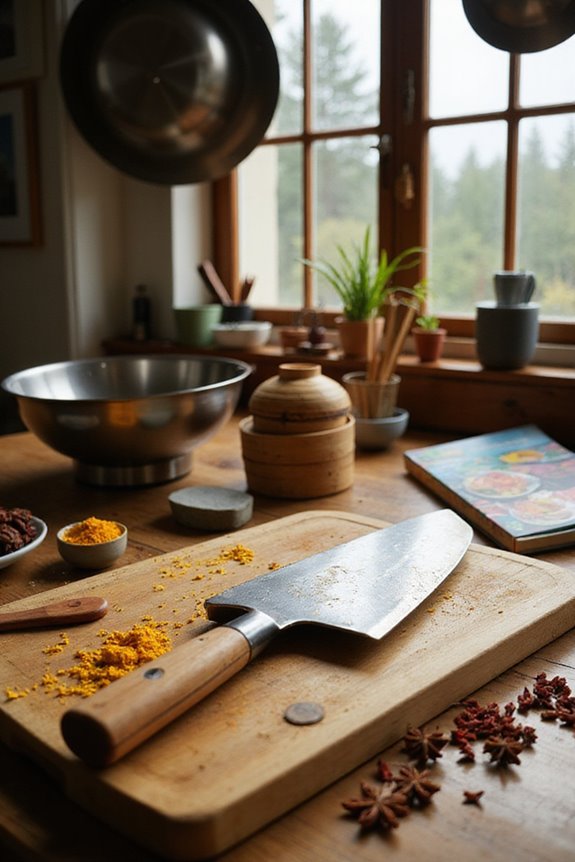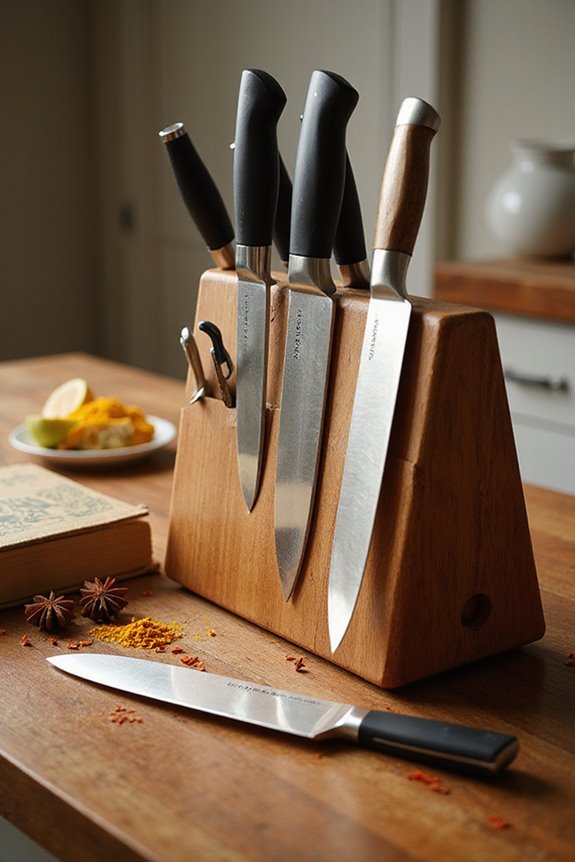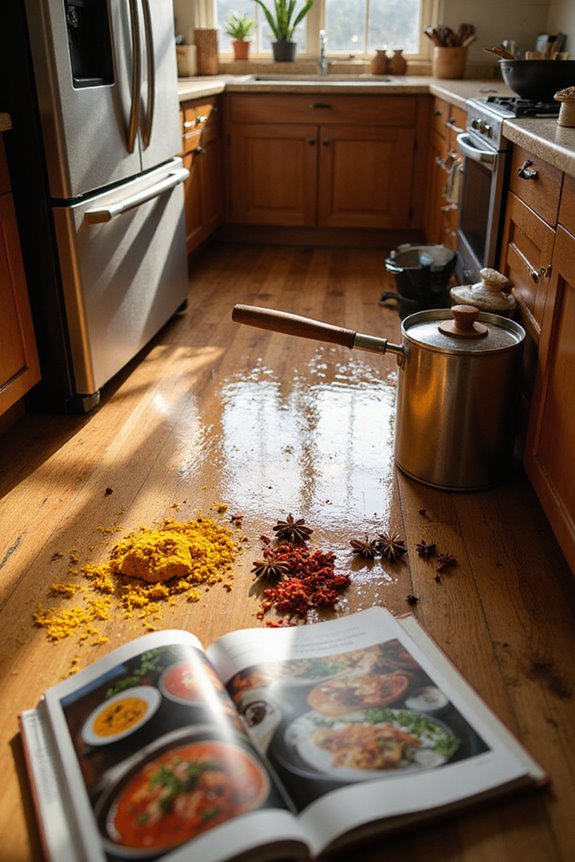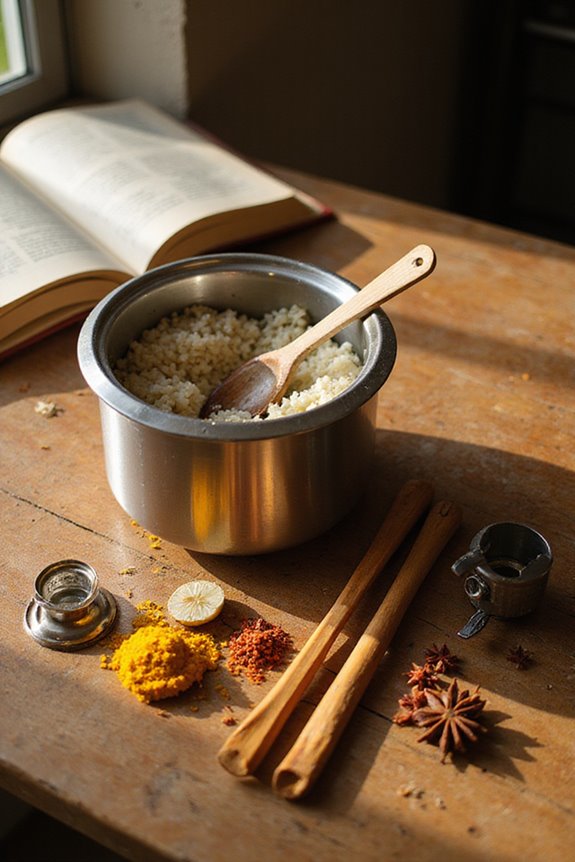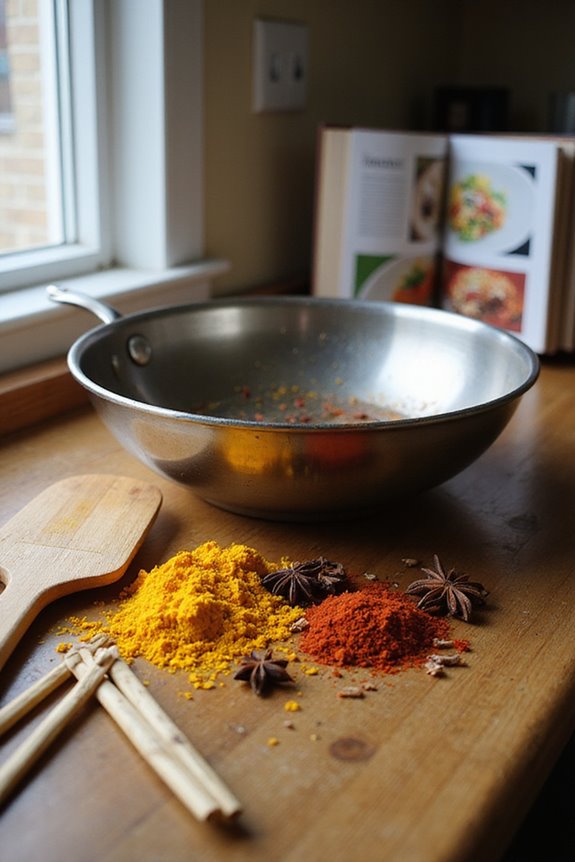If our knife won’t stay sharp, it’s time to sprinkle a little magic on it! First, let’s check for common causes like corrosion, improper storage, or cutting on hard surfaces. Next, regular maintenance is key! We should wash our knives gently and use a honing rod weekly. For sharpening, a whetstone at 1000 grit is like finding gold! Now, let’s explore more tips on choosing the right tools and keeping our blades as delightful as a holiday feast!
Key Takeaways
- Regularly hone your knife weekly to realign the edge and maintain sharpness between sharpening sessions.
- Sharpen your knife every 1-2 months, or monthly for daily users, to restore its cutting performance.
- Check your sharpening technique, ensuring a consistent angle of 15° to 20° and the presence of a burr during sharpening.
- Store knives properly in a block or magnetic strip to prevent edge damage from friction or contact with other utensils.
- Use appropriate cutting surfaces, such as wood or plastic, to minimize wear and preserve the blade’s edge.
Common Causes of Dullness
When we think about our favorite holiday meals, we often imagine the delicious flavors, the delightful gatherings, and, of course, the shiny, sharp knives we use to prepare everything. However, our beloved blades can lose their magic. Here are some common causes of dullness:
- Friction and Abrasion: Tough foods wear down blade materials, creating dullness over time.
- Corrosion: Moisture and acidic ingredients dull edges faster than a holiday scare story!
- Improper Storage: Loose drawers scratch sharp edges, causing unwelcome nicks.
- Wrong Surfaces: Cutting on hard surfaces like glass can ruin those sharpening angles we love. Additionally, regular honing is essential for maintaining knife sharpness without the need for frequent full sharpening.
Let’s remember, maintaining knife sharpness makes our cooking adventures delightful! By caring for our knives, we can keep that holiday spirit alive with every slice and chop.
Importance of Proper Maintenance
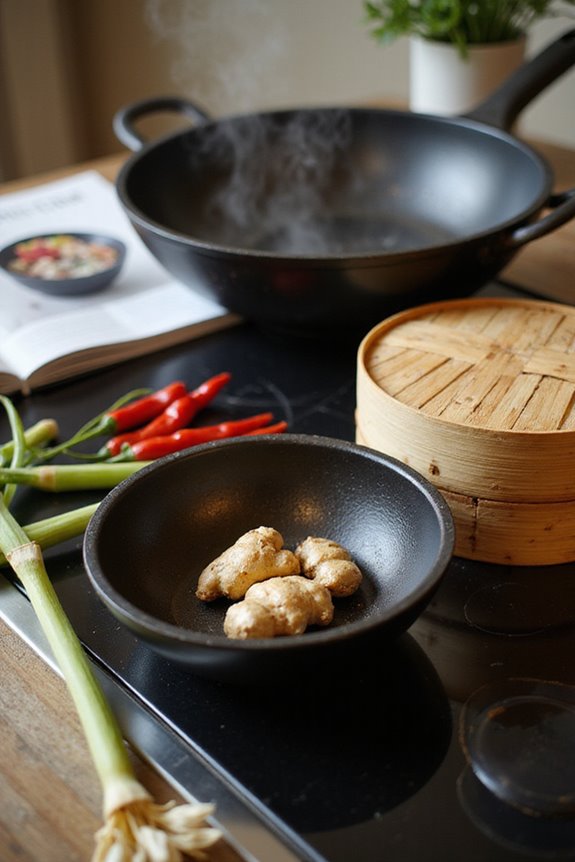
Knife Cleaning:
- Always hand wash our knives with mild soap and warm water.
- Clean them immediately after use to prevent stubborn residue.
- Avoid harsh chemicals; stick to gentle soap! Premium knife sets typically come with extensive warranties that can assure you of their long-lasting performance and quality.
Storage Solutions:
- Use knife blocks for protection and great looks.
- Magnetic strips help keep things organized and safe.
- Avoid storing them in drawers to prevent damage.
Effective Sharpening Techniques
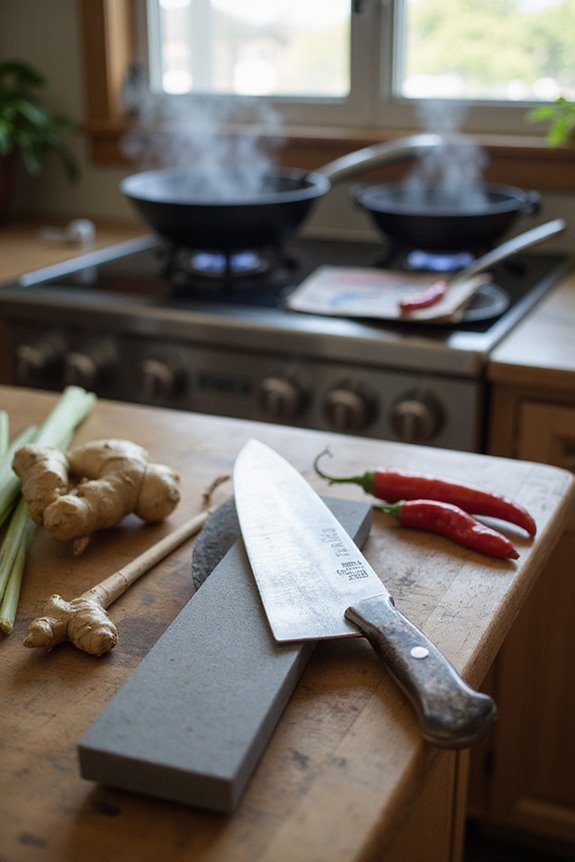
Sharpening our knives might feel like transforming a kitchen tool into a magical wand! With some simple sharpening techniques, we can release their true potential. First, we start with a lower grit whetstone, around 1000 grit, to remove dullness and damage. Then, we progress to a finer grit, about 6000, for that delightful polish. Remember to keep a consistent angle of 15° to 20° while gliding our knife across the stone in smooth strokes. Don’t forget to check for that burr—it’s our little sign of success! Taking good care of our whetstone by soaking it helps create that lovely slurry for efficient sharpening. Additionally, using high-quality materials like high-carbon stainless steel can enhance edge retention, allowing us to enjoy sharper blades for longer periods. With practice, our blades will be as sharp as our culinary dreams!
Choosing the Right Tools
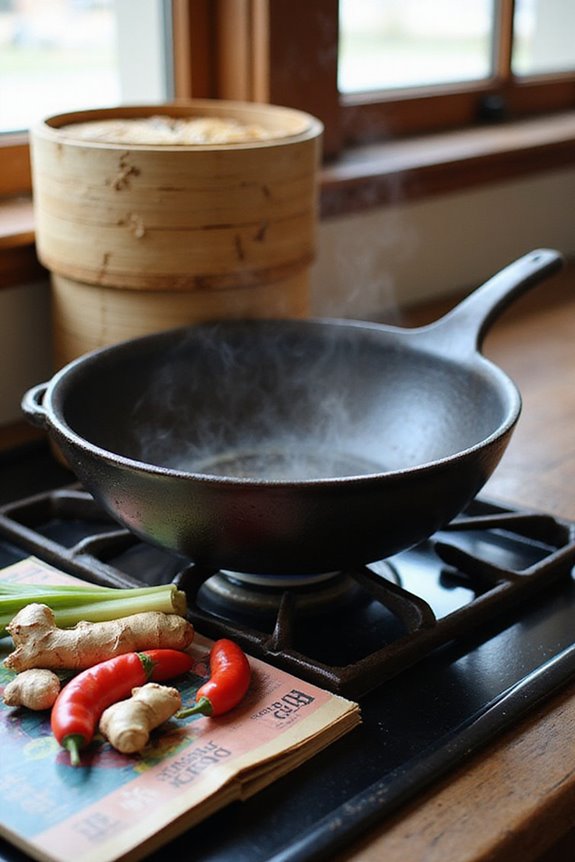
Here’s a quick guide:
- Electric sharpeners: Speedy, adjustable, ideal for busy kitchens.
- Manual sharpeners: Portable, affordable, great for a more hands-on approach.
No matter what we choose, having the right toolkit can turn our kitchen tasks into something truly delightful! It’s important to consider the materials and durability of our knives as this affects their longevity and performance.
Frequency of Sharpening and Honing

In our culinary adventures, we should frequently check and maintain the sharpness of our trusty knives. Creating sharpening schedules helps us know when it’s time to sharpen—every 1-2 months is a good rule of thumb for most of us. If we’re real kitchen warriors using our knives daily, we might even need to sharpen monthly!
Don’t forget about honing! Regular honing intervals, like doing it weekly, keeps our blades feeling delightful and sharp. It’s a simple way to realign those edges without removing too much material. So, grab that honing rod and treat it like a magical wand! Together, we’ll keep our knives at their best, ready for all our delicious culinary creations. Additionally, using a well-maintained carbon steel wok can enhance your cooking and minimize the need for frequent knife sharpening due to its efficient heat distribution. Happy slicing!
Tips for Preventing Edge Damage
Keeping our knives in tip-top shape is like giving them a delightful spa day! To prevent edge damage, let’s embrace some fun edge protection strategies. Here are a few storage solutions we can all try:
- Knife Blocks or Magnetic Strips: These keep blades separate, reducing dulling from contact.
- Blade Guards: Use them for extra cushioning when storing or transporting our favorite knives.
- Avoid Drawer Clutter: Storing knives loosely can lead to chips; let’s not let them play “knife tag” in there!
Additionally, chopping on soft surfaces like wood or plastic helps us keep that magical edge intact. With just a little care, we’ll be on our way to cooking greatness while preserving our trusty kitchen companions! Happy slicing! It’s also crucial to invest in high-quality carbon steel cleavers to ensure excellent sharpness and durability over time.
Recognizing When to Sharpen
Ever wondered how to tell if our trusty knives are losing their magic? Recognizing when to sharpen can be a delightful game! We can start with a visual inspection: hold the knife under good light and check for shiny edges, nicks, or dull spots. Next, let’s put our knives to the test! If they drag or require us to push hard, it’s time for a sharpening session. Try some fun performance tests: slice through a tomato or a piece of paper. If it squishes or tears, we definitely need to sharpen. Keeping our knives sharp not only makes cooking pleasant; it keeps us safe. Remember, a sharp knife is like a holiday treat – a joy to handle!
Mistakes to Avoid When Sharpening
After we’ve mastered the art of recognizing when our knives need a bit of love, it’s time to perfect our sharpening skills. Let’s avoid some common sharpening errors that can ruin our culinary magic!
- Angle Inconsistencies: Keeping a constant angle is essential. If we veer off, our knives won’t cut right—it’s like trying to bake a cake without measuring!
- Uneven Pressure: We shouldn’t press too hard; it can damage the blade like dropping Aunt Millie’s famous fruitcake.
Remember to use the whole whetstone surface and create that delightful burr! And finally, let’s not skip steps or rush—great knives take time, just like grandma’s holiday cookies! By steering through these sharpening mistakes together, we’ll be on our way to delightful cutting experiences!
Enhancing Knife Longevity and Performance
To guarantee our knives have a long and productive life in the kitchen, we need to treat them with a little love and care. Start by cleaning, using warm water and mild soap right after slicing that delightful holiday ham. Always dry them gently with a soft cloth to prevent rust, especially on carbon steel blades.
Next, let’s talk sharpening! Regularly hone our knives with honing rods and avoid over-sharpening. And don’t forget about safe storage—keep them in a dry place, using protective sheaths or magnetic blocks. Finally, always use the right cutting techniques. Happy chopping! With these tips, we’ll guarantee our knives shine and perform like culinary superheroes!
Frequently Asked Questions
Can a Dull Knife Be Fixed Without Professional Sharpening?
Absolutely, we can fix a dull knife ourselves! With effective sharpening techniques and maintenance tips, like honing regularly and proper storage, we’ll keep our knives sharp and ready for anything in the kitchen!
How Does the Type of Blade Material Affect Sharpness?
So, we all think every knife’s a little miracle, right? Well, blade composition really shapes sharpness! Knowing our materials and sharpening techniques can make the difference between slicing with joy or wrestling with dinner.
Is It Safe to Use a Dull Knife?
It’s really not safe to use a dull knife. The dull knife risks can lead to serious injuries, compromising our kitchen safety. Let’s prioritize keeping our knives sharp and our cooking experiences enjoyable and secure.
What Environmental Factors Contribute to Knife Dullness?
When we slice through soft vegetables, the wrong cutting surfaces and high humidity levels can cause our knives to dull quickly. Together, we can protect our blades by choosing safe surfaces and controlling moisture.
Can I Sharpen My Knife on a Ceramic Plate?
We can use a ceramic plate for some knife maintenance, but it’s not true ceramic sharpening. It helps realign the edge, extending our knife’s life, but we should be cautious to avoid damaging the blade.

